

Curiosity rover finds active, ancient organic chemistry on Mars. (Phys.org)—NASA's Mars Curiosity rover has measured a tenfold spike in methane, an organic chemical, in the atmosphere around it and detected other organic molecules in a rock-powder sample collected by the robotic laboratory's drill.
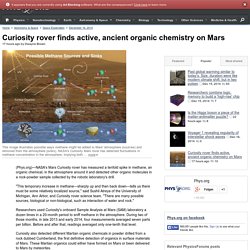
"This temporary increase in methane—sharply up and then back down—tells us there must be some relatively localized source," said Sushil Atreya of the University of Michigan, Ann Arbor, and Curiosity rover science team. "There are many possible sources, biological or non-biological, such as interaction of water and rock. " Researchers used Curiosity's onboard Sample Analysis at Mars (SAM) laboratory a dozen times in a 20-month period to sniff methane in the atmosphere.
During two of those months, in late 2013 and early 2014, four measurements averaged seven parts per billion. Before and after that, readings averaged only one-tenth that level. Error loading skin: Error loading file. Mars Rover Curiosity Drills 1st Sample of Huge Martian Mountain. NASA's Mars rover Curiosity has taken its first bite out of the giant mountain that it crossed interplanetary space to explore.
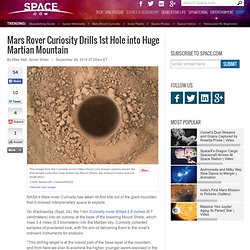
On Wednesday (Sept. 24), the 1-ton Curiosity rover drilled 2.6 inches (6.7 centimeters) into an outcrop at the base of the towering Mount Sharp, which rises 3.4 miles (5.5 kilometers) into the Martian sky. Curiosity Finds a Weird 'Ball' on Mars. If there’s one thing to be said for Curiosity’s mission on Mars so far, it certainly hasn’t been boring.

Although the six-wheeled rover has taken thousands of photographs of Martian rocks, the rich diversity of Mars’ landscape has provided many beautiful examples of planetary geology and some geology that is downright weird. PHOTOS: Top 10 Weirdest Mars Illusions and Pareidolia Take this recent photographic example from the Mars Science Laboratory’s Mastcam camera that was uploaded to the mission’s photo archive on sol 746 (Sept. 11). While compiling a mosaic of images of the surrounding landscape, Curiosity captured a rather un-Mars-like shape atop a rocky outcrop. There’s a perfect-looking sphere sitting proudly on a flat rock surface. At first glance it looks like an old cannonball or possibly a dirty golf ball. Curiosity Rover Packs Up Drill, Hits the Martian Road Again. NASA's Mars rover Curiosity has passed up a potential drilling target and instead resumed the long trek to a huge Red Planet mountain.

Mission team members had been considering drilling a Mars rock dubbed "Bonanza King" but scrapped the idea after pre-drilling activities suggested that the stone is not stable enough, NASA officials said. "We have decided that the rocks under consideration for drilling, based on the tests we did, are not good candidates for drilling," Curiosity project manager Jim Erickson, of NASA's Jet Propulsion Laboratory in Pasadena, California, said in a statement. "Instead of drilling here, we will resume driving toward Mount Sharp. " Curiosity Rover on Mars Leaves Landing 'Safe Zone' NASA's Mars rover Curiosity has entered a new realm on the Red Planet.
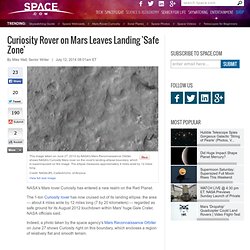
The 1-ton Curiosity rover has now cruised out of its landing ellipse, the area — about 4 miles wide by 12 miles long (7 by 20 kilometers) — regarded as safe ground for its August 2012 touchdown within Mars' huge Gale Crater, NASA officials said. Indeed, a photo taken by the space agency's Mars Reconnaissance Orbiter on June 27 shows Curiosity right on this boundary, which encloses a region of relatively flat and smooth terrain. Curiosity landed with the aid of a rocket-powered sky crane, which lowered the six-wheeled robot down softly on cables before flying off to crash-land intentionally a safe distance away.
This system, which had never been used before at Mars, allowed Curiosity to land with much more precision than previous Red Planet missions had been able to achieve. For example, NASA's twin Spirit and Opportunity rovers landed inside an ellipse measuring 93 miles by 12 miles (150 by 20 km) in January 2004. Curiosity travels through ancient glaciers on Mars. 25-Jun-2014 [ Print | E-mail ] Share [ Close Window ] Contact: Press Officeinfo@agenciasinc.es 34-914-251-820FECYT - Spanish Foundation for Science and Technology 3,500 million years ago the Martian crater Gale, through which the NASA rover Curiosity is currently traversing, was covered with glaciers, mainly over its central mound.
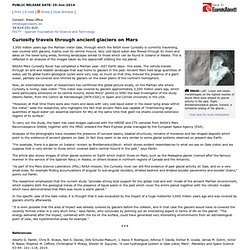
Very cold liquid water also flowed through its rivers and lakes on the lower-lying areas, forming landscapes similar to those which can be found in Iceland or Alaska. Bacteria species part of Curiosity baggage on Mars. (Phys.org) —When the Curiosity rover landed on Mars in 2012, there may have been dozens of microbial species, having withstood pre-launch spacecraft cleaning.
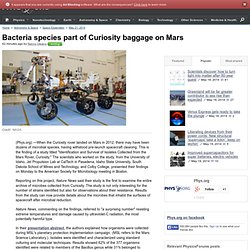
This is the finding of a study titled "Identification and Survival of Isolates Collected from the Mars Rover, Curiosity. " The scientists who worked on the study, from the University of Idaho, Jet Propulsion Lab at CalTech in Pasadena, Idaho State University, South Dakota School of Mines and Technology, and Colby College, presented their findings on Monday to the American Society for Microbiology meeting in Boston. Reporting on this project, Nature News said their study is the first to examine the entire archive of microbes collected from Curiosity. The study is not only interesting for the number of strains identified but also for observations about their resistance.
Results from the study can now provide details about the microbes that inhabit the surfaces of spacecraft after microbial reduction. NASA Curiosity Rover To Drill First Martian Sandstone 'Windjana' By Rebekah Marcarelli r.marcarelli@hngn.com | Apr 27, 2014 02:48 PM EDT.

Curiosity Photographs the Earth and Moon from Mars. Want to feel insignificant?

Look at this photograph taken by Mars rover Curiosity. See that tiny spot that looks like a star? In fact, it likely looks more like a speck of dust on your screen. Well, that’s not a star or dust, that’s a planet — Planet Earth to be precise. PHOTOS: Distant Earth: A History of ‘Pale Blue Dots’ Here’s an annotated view in case you need some help in finding it: On Jan. 31 (sol 529 of its mission), Curiosity looked toward the twilit horizon about 80 minutes after sunset and took a few shots with its Mastcam knowing that Earth would be in view.
Like the many “Pale Blue Dots” taken by a growing number of space missions, this shot embodies our feeling of solitude in the great vastness of space. “From this distant vantage point, the Earth might not seem of any particular interest. Rough Roving: Curiosity's Wheel Damage 'Accelerated' In May, Discovery News reported the dramatic signs of wear and tear on Mars rover Curiosity’s wheels.
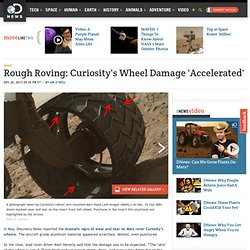
The aircraft-grade aluminum material appeared scratched, dented, even punctured. At the time, lead rover driver Matt Heverly said that the damage was to be expected. “The ‘skin’ of the wheel is only 0.75mm thick and we expect dents, dings, and even a few holes due to the wheels interacting with the rocks,” he said via email. Despite the assurances that the holes were just a part of Curiosity’s mission, there seems to be increasing concern for the wheels’ worsening condition after the one-ton robot rolled over some craggy terrain. Mars Rover Curiosity Spotted from Space. New photos by a sharp-eyed NASA Mars orbiter show the space agency's Curiosity rover trundling across the Red Planet, on its way to the base of a huge and mysterious mountain.
The 1-ton Curiosity rover and its tracks are visible in two new images taken by the High Resolution Imaging Science Experiment (HiRISE) camera aboard NASA's Mars Reconnaissance Orbiter on Dec. 11, 2013. "The rover is near the lower-left corner of this view," NASA officials wrote in a description of one of the photos, which was released today (Jan. 9).
"For scale, the two parallel lines of the wheel tracks are about 10 feet (3 meters) apart. "